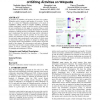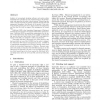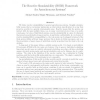791 search results - page 149 / 159 » Users and Trust in Cyberspace |
EDCC
1994
Springer
13 years 11 months ago
1994
Springer
Security and reliability issues in distributed systems have been investigated for several years at LAAS using a technique called Fragmentation-Redundancy-Scattering (FRS). The aim ...
AVI
2010
13 years 9 months ago
2010
To increase its credibility and preserve the trust of its readers, Wikipedia needs to ensure a good quality of its articles. To that end, it is critical for Wikipedia administrato...
SCS
2004
13 years 9 months ago
2004
Industry is increasingly adopting software and system safety standards that mandate the use of hazard logs in the development and operation of safety critical systems. Hazard logs...
AIS
2006
Springer
13 years 7 months ago
2006
Springer
Today's computer network technologies are sociologically founded on hunter-gatherer principles; common users may be possible subjects of surveillance and sophisticated Interne...
IANDC
2007
13 years 7 months ago
2007
We define reactive simulatability for general asynchronous systems. Roughly, simulatability means that a real system implements an ideal system (specification) in a way that pre...



